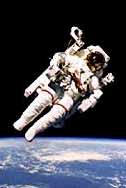|
> History > Human in Space > Recent & Future Developments
|
Space is a hostile environment for human beings in a number of ways. It contains neither air nor oxygen, so human beings are unable to breathe. The vacuum of space can destroy an unprotected human body in a few seconds by explosive decompression. Temperatures in space in the shadow of a planet approach absolute zero; on the other hand, temperatures can become fatally high under direct solar radiation. Energetic solar and cosmic radiations in space may also be fatal to an unshielded person who is not protected by the atmosphere of the Earth. These environmental conditions can also affect the instruments and devices used in spacecraft, so the design and construction of these materials are dictated by the space environment. Experiments in weightlessness for long periods of time have been studied intensively to discover what adverse effects this condition will have on travelers in space.
People can be protected against the space environment in several ways.
At present, they are enclosed inside a hermetically sealed cabin or space
suit, with a supply of pressurized air or oxygen to approximate conditions
on Earth. Air conditioning controls the temperature and humidity.
Absorbing and reflecting surfaces on the outside of the spacecraft
regulate the amount of heat radiation affecting the craft. Furthermore,
space journeys are carefully planned to avoid the intense radiation belts
around the Earth. On long interplanetary voyages of the future, heavy
shielding might be necessary to protect against solar radiation storms; or
crews might be sheltered in a central position within the spacecraft with
supplies and equipment to surround and shield them. For lengthy space
journeys, or for prolonged stays in an Earth-orbiting satellite, the
effects of weightlessness might be reduced by spinning the craft to
provide artificial gravity. For this purpose, the spacecraft might be
shaped like a large wheel that spins slowly around its own axis, or like a
dumbbell, rotating end over end. |
